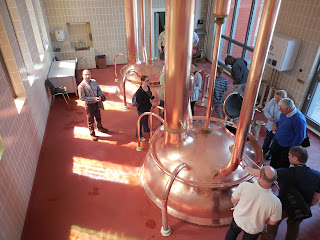I don't suppose my drinking habits have changed that much since then, but I have realised that in most countries the drinking starts and finishes later so I at least have more chance of reaching a respectable hour before I get tired and emotional.
So having no expectations about the next visit on our trip I was absolutely blown away by what a beautiful brewery Rochefort is.
The gleaming copper vessels are actually still used.
There was no mash filter in the building next door here.
And the copper vessels weren't shells hiding stainless steel ones.
The brewhouse dates from 1962 and the recipes have remained essentially unchanged since then. The monastery was founded in 1230 and probably brewed, but the earliest brewing record is from 1595. The French revolution saw the end of the monastery though, and monks didn't return until 1890. There are various historical things in the cellar but it's not all old fashioned.
Here's a centrifuge:
...and cylindroconical fermenters:
...er...and a paraflow and bottling line. I really should have got this written up sooner.
The numbers on the beers refer to an old Belgian system for measuring gravity, which was almost as sensible as degrees sacch. Rochefort 6 has a gravity of 1.060, 8 is 1.080 and 10 is 1.100. The 8 is made from pale malt, wheat starch, white and brown sugar, with Aramis and Styrian golding hops. Aramis is one of Peter Darby's hop varieties so comes from considerably later than 1962, though were told it was replacing Hallertau. The grist provides about three quarters of the extract and the sugars the rest. The hops are pelletised and caramel is used for colour.
Nine brews a week are carried out over four days. A 90 minute boil gives only 4% evaporation to the 100 hl brew length, for which 1500kg of grain are used. The mash is long at 2 hours and 20 minutes, starting at 63°C and rising to 74°C. The beer spends a week in the fermenter at 22°C and then is cooled to 15°C for two days and centrifuged. Conditioning takes three weeks in flat bottomed tanks. A degree plato's worth of invert sugar is added along with yeast for bottling, Rochefort 8 getting 3 million cells per ml and 10 4-5 million. CO2 rises from 2g/l to 7 due to the bottle conditioning.
Unlike at Orval, I did actually manage to spot one of the monks here. There are 13 of them.
I don't know how much beer the monks get through but it must be a perk of the job, and after this visit I know I'll be drinking more Rochefort.
 |
| Hmm..how many bottles are left? |








This is work is it? Excellent.
ReplyDeleteIt was work for some of the people on the trip but I had to take holiday and pay for it myself.
ReplyDelete